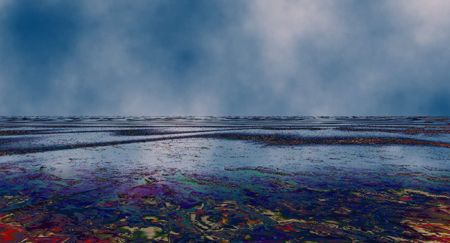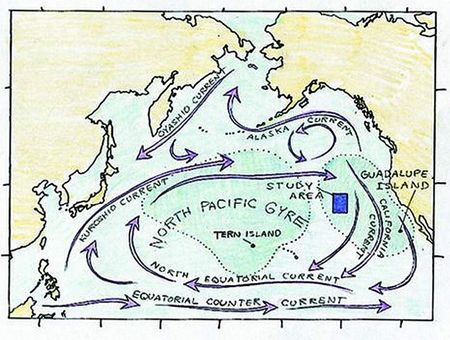Sailing into the Horror
The Garbage Path by Guido Cavalcante
[Click on the image above to see a large-scale version.]
Editor's Note: This is a guest posting by Guido Cavalcante. His image was made using Ultra Fractal. Excerpts in this post were taken from "Our Oceans Are Turning into Plastic...Are We?" by Susan Casey. For more information about the Great Pacific Garbage Patch, please see this post at RTSea blog. The current print edition of Rolling Stone also has an excellent article on the floating plastic mass: "The Great Pacific Garbage Patch" by Kitt Couchette. To illustrate the severity of plastic debris polluting the world's oceans and waterways, Couchette notes: "On British coastlines in the North Sea, a study of fulmars found that 95 per cent of the seabirds had plastic in their stomachs, with an average of 44 pieces per bird. A proportional amount in a human being would weigh nearly five pounds."
Orbit Trap welcomes guest posts on fractal art topics. Query the editors using the email link in the sidebar.
~/~
The facts happened twelve years ago.
It was August 3, 1997. A sunny day with little wind, Captain Charles Moore and the crew of Alguita, his 50-foot aluminum-hulled catamaran, sliced through the sea.
Returning to Southern California from Hawaii after a sailing race, Moore had altered Alguita’s course through the eastern corner of a 10-million-square-mile oval known as the North Pacific subtropical gyre. This was an odd stretch of ocean, a place most boats purposely avoided. So did the ocean’s top predators: the tuna, sharks, and other large fish that required livelier waters, flush with prey. The gyre was more like a desert -- a slow, deep, clockwise-swirling vortex of air and water caused by a mountain of high-pressure air that lingered above it.
Map of the gyre. The blue square represents one study of the garbage patch.
[Click on the image above to see a large-scale version.]
The area’s reputation didn’t deter Moore. He had spent countless hours in the ocean, fascinated by its vast trove of secrets and terrors. But he had never seen anything nearly as chilling as what lay ahead of him in the gyre.It began with a line of plastic bags ghosting the surface, followed by an ugly tangle of junk: nets and ropes and bottles, motor-oil jugs and cracked bath toys, a mangled tarp. Tires. A traffic cone. Moore could not believe his eyes. Out here in this desolate place, the water was a stew of plastic crap. It was as though someone had taken the pristine seascape of his youth and swapped it for a landfill.
How did all the plastic end up here? As the Alguita glided through the area that scientists now refer to as the “Eastern Garbage Patch,” Moore realized that the trail of plastic went on for hundreds of miles. Depressed and stunned, he sailed for a week through bobbing, toxic debris trapped in a purgatory of circling currents. To his horror, he had stumbled across the 21st-century Leviathan. It had no head, no tail. Just an endless body.
The memory excerpts above of the first encounter with the Garbage Patch remain one of the most terrible discoveries of the century. My image tries to represent the surprise of the horror. I think it is the first time the Patch has been graphically represented, except for photos. For those that want to read the six page description which leads me into the adventure of making an image tied with the reality, it is here:
--Guido Cavalcante
~/~
Tags: fractal, fractals, fractal art, fractal blog, guido cavalcante, the garbage path, great pacific garbage patch, captain charles moore, sailing into the horror, orbit trap






0 Comments:
Post a Comment
<< Home